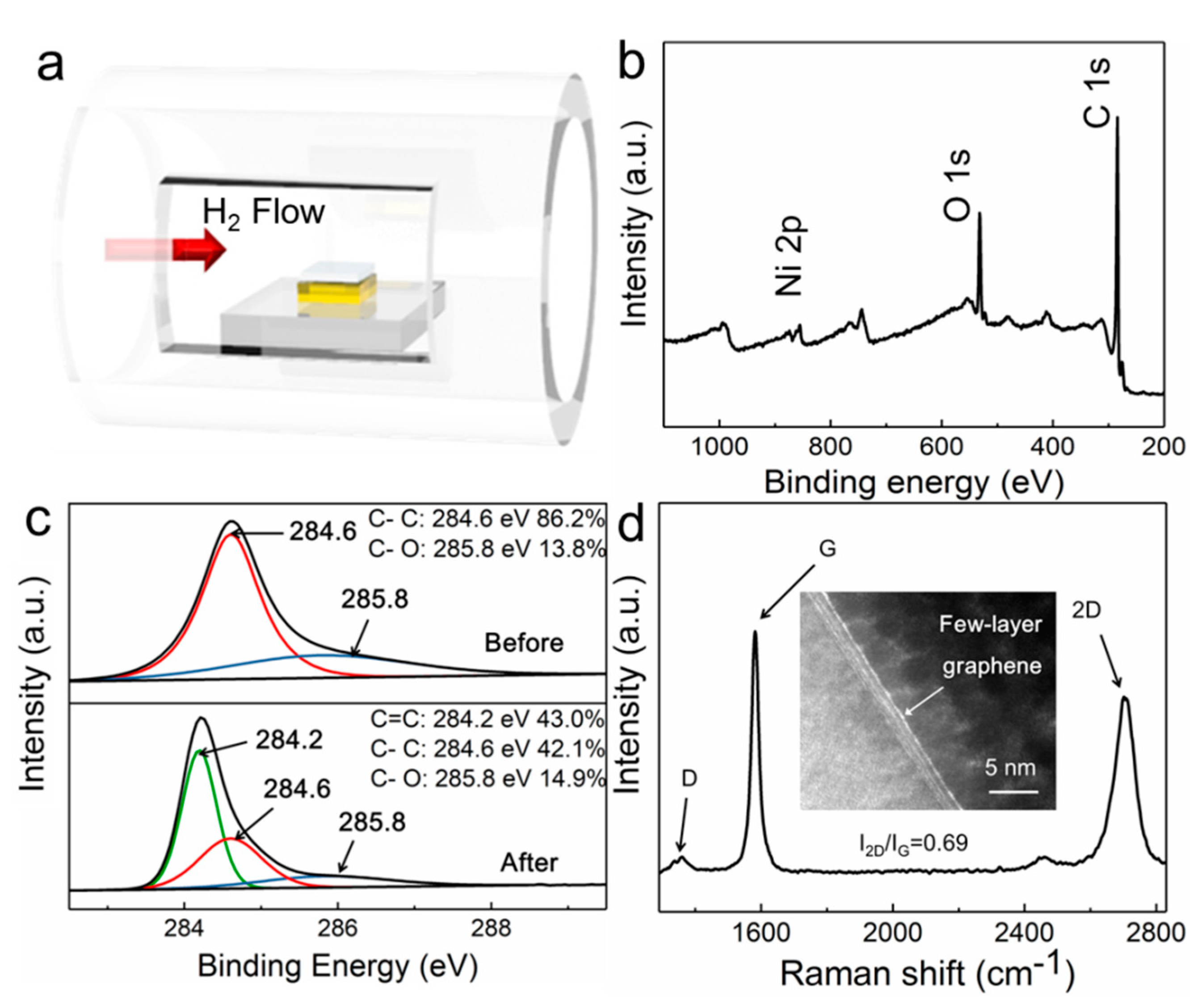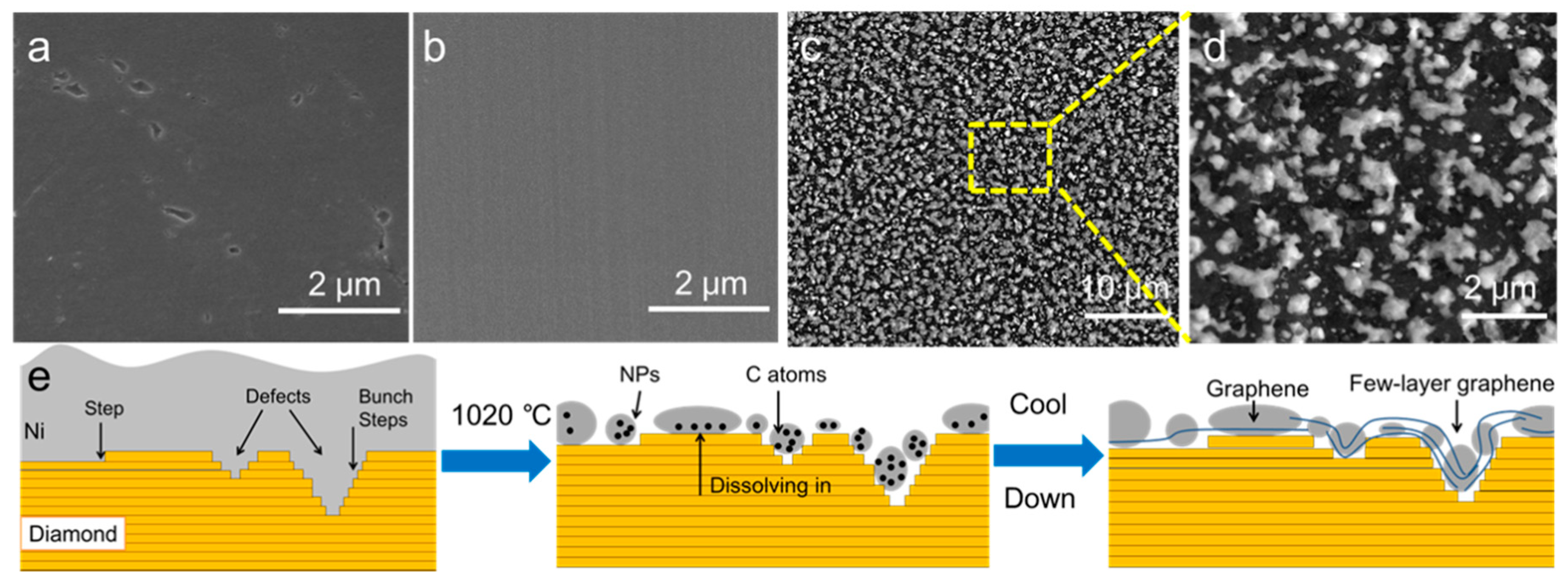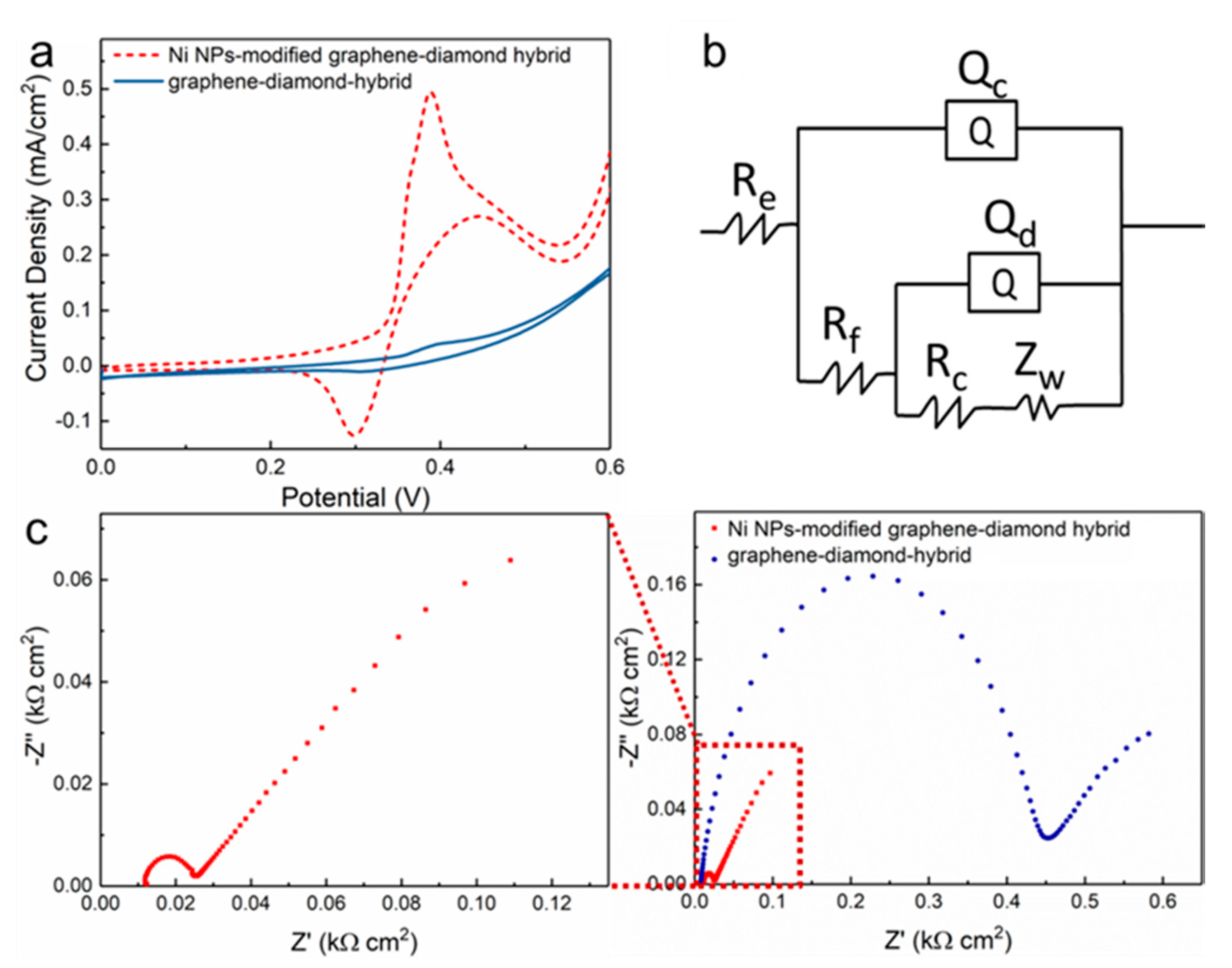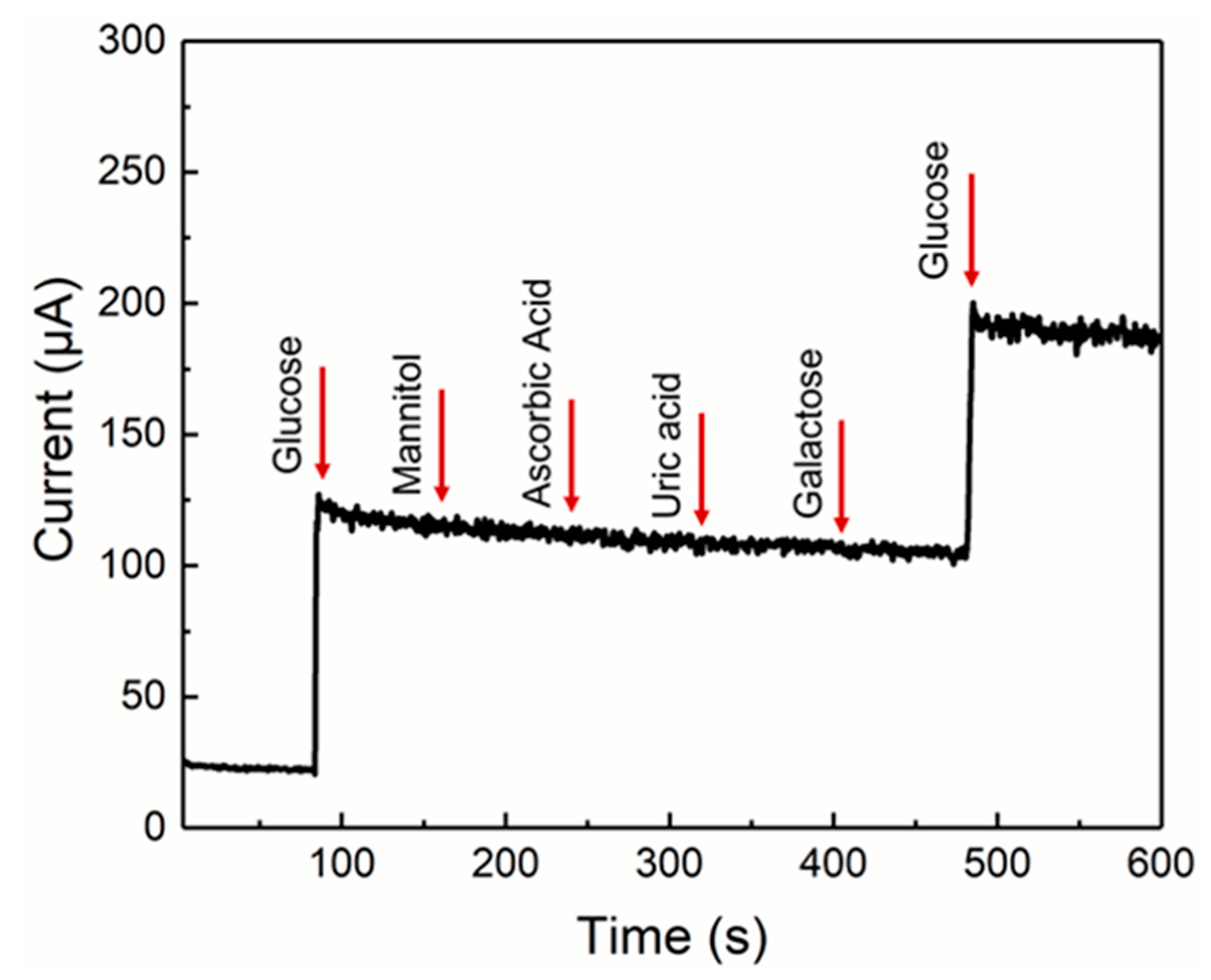Single-Step Formation of Ni Nanoparticle-Modified Graphene–Diamond Hybrid Electrodes for Electrochemical Glucose Detection
Abstract
1. Introduction
2. Materials and Methods
3. Results and Discussion
4. Conclusions
Author Contributions
Funding
Conflicts of Interest
References
- Ci, S.; Huang, T.; Wen, Z.; Cui, S.; Mao, S.; Steeber, D.A.; Chen, J. Nickel oxide hollow rnicrosphere for non-enzyme glucose detection. Biosens. Bioelectron. 2014, 54, 251–257. [Google Scholar] [CrossRef] [PubMed]
- Fu, S.; Fan, G.; Yang, L.; Li, F. Non-enzymatic glucose sensor based on Au nanoparticles decorated ternary Ni-Al layered double hydroxide/single-walled carbon nanotubes/graphene nanocomposite. Electrochim. Acta 2015, 152, 146–154. [Google Scholar] [CrossRef]
- Heidari, H.; Habibi, E. Amperometric enzyme-free glucose sensor based on the use of a reduced graphene oxide paste electrode modified with electrodeposited cobalt oxide nanoparticles. Microchim. Acta 2016, 183, 2259–2266. [Google Scholar] [CrossRef]
- Kim, D.-M.; Moon, J.-M.; Lee, W.-C.; Yoon, J.-H.; Choi, C.S.; Shim, Y.-B. A potentiometric non-enzymatic glucose sensor using a molecularly imprinted layer bonded on a conducting polymer. Biosens. Bioelectron. 2017, 91, 276–283. [Google Scholar] [CrossRef] [PubMed]
- Qiao, N.; Zheng, J. Nonenzymatic glucose sensor based on glassy carbon electrode modified with a nanocomposite composed of nickel hydroxide and graphene. Microchim. Acta 2012, 177, 103–109. [Google Scholar] [CrossRef]
- Amjadi, M.; Shokri, R.; Hallaj, T. Interaction of glucose-derived carbon quantum dots with silver and gold nanoparticles and its application for the fluorescence detection of 6-thioguanine. Luminesence 2017, 32, 292–297. [Google Scholar] [CrossRef] [PubMed]
- Chen, J.; Gao, Y.; Ma, Q.; Hu, X.; Xu, Y.; Lu, X. Turn-off fluorescence sensor based on the 5,10,15,20-(4-sulphonatophenyl) porphyrin (TPPS4)-Fe2+ system: Detecting of hydrogen peroxide (H2O2) and glucose in the actual sample. Sens. Actuators B Chem. 2018, 268, 270–277. [Google Scholar] [CrossRef]
- Clark, L.C.; Lyons, C. Electrodes systems for continuous monitoring in cardiovascular surgery. Ann. N. Y. Acad. Sci. 1963, 102, 29–45. [Google Scholar] [CrossRef]
- Jothi, L.; Jayakumar, N.; Jaganathan, S.K.; Nageswaran, G. Ultrasensitive and selective non-enzymatic electrochemical glucose sensor based on hybrid material of graphene nanosheets/graphene nanoribbons/nickel nanoparticle. Mater. Res. Bull. 2018, 98, 300–307. [Google Scholar] [CrossRef]
- Jiang, D.; Liu, Q.; Wang, K.; Qian, J.; Dong, X.; Yang, Z.; Du, X.; Qiu, B. Enhanced non-enzymatic glucose sensing based on copper nanoparticles decorated nitrogen-doped graphene. Biosens. Bioelectron. 2014, 54, 273–278. [Google Scholar] [CrossRef]
- Said, K.; Ayesh, A.I.; Qamhieh, N.N.; Awwad, F.; Mahmoud, S.T.; Hisaindee, S. Fabrication and characterization of graphite oxide-nanoparticle composite based field effect transistors for non-enzymatic glucose sensor applications. J. Alloy. Compd. 2017, 694, 1061–1066. [Google Scholar] [CrossRef]
- Nie, H.; Yao, Z.; Zhou, X.; Yang, Z.; Huang, S. Nonenzymatic electrochemical detection of glucose using well-distributed nickel nanoparticles on straight multi-walled carbon nanotubes. Biosens. Bioelectron. 2011, 30, 28–34. [Google Scholar] [CrossRef] [PubMed]
- Soomro, R.A.; Ibupoto, Z.H.; Uddin, S.; Abro, M.I.; Willander, M. Electrochemical sensing of glucose based on novel hedgehog-like NiO nanostructures. Sens. Actuators B Chem. 2015, 209, 966–974. [Google Scholar] [CrossRef]
- Zhang, X.; Zhang, Z.; Liao, Q.; Liu, S.; Kang, Z.; Zhang, Y. Nonenzymatic glucose sensor based on in situ reduction of Ni/NiO-graphene nanocomposite. Sensors 2016, 16, 1791. [Google Scholar] [CrossRef] [PubMed]
- Zhang, Y.; Su, L.; Manuzzi, D.; de los Monteros, H.V.E.; Jia, W.; Huo, D.; Hou, C.; Lei, Y. Ultrasensitive and selective non-enzymatic glucose detection using copper nanowires. Biosens. Bioelectron. 2012, 31, 426–432. [Google Scholar] [CrossRef] [PubMed]
- Chou, C.-H.; Chen, J.-C.; Tai, C.-C.; Sun, I.W.; Zen, J.-M. A nonenzymatic glucose sensor using nanoporous platinum electrodes prepared by electrochemical alloying/dealloying in a water-insensitive zinc chloride-1-ethyl-3-methylimidazolium chloride ionic liquid. Electroanalysis 2008, 20, 771–775. [Google Scholar] [CrossRef]
- Ding, Y.; Wang, Y.; Su, L.; Bellagamba, M.; Zhang, H.; Lei, Y. Electrospun Co3O4 nanofibers for sensitive and selective glucose detection. Biosens. Bioelectron. 2010, 26, 542–548. [Google Scholar] [CrossRef] [PubMed]
- Tang, X.; Zhang, B.; Xiao, C.; Zhou, H.; Wang, X.; He, D. Carbon nanotube template synthesis of hierarchical NiCoO2 composite for non-enzyme glucose detection. Sens. Actuators B Chem. 2016, 222, 232–239. [Google Scholar] [CrossRef]
- Zhang, P.; Zhang, L.; Zhao, G.; Feng, F. A highly sensitive nonenzymatic glucose sensor based on CuO nanowires. Microchim. Acta 2012, 176, 411–417. [Google Scholar] [CrossRef]
- Toghill, K.E.; Compton, R.G. Electrochemical non-enzymatic glucose sensors: A perspective and an evaluation. Int. J. Electrochem. Sci. 2010, 5, 1246–1301. [Google Scholar]
- You, T.Y.; Niwa, O.; Chen, Z.L.; Hayashi, K.; Tomita, M.; Hirono, S. An amperometric detector formed of highly dispersed Ni nanoparticles embedded in a graphite-like carbon film electrode for sugar determination. Anal. Chem. 2003, 75, 5191–5196. [Google Scholar] [CrossRef] [PubMed]
- Safavi, A.; Maleki, N.; Farjami, E. Fabrication of a glucose sensor based on a novel nanocomposite electrode. Biosens. Bioelectron. 2009, 24, 1655–1660. [Google Scholar] [CrossRef] [PubMed]
- Shen, Z.; Gao, W.; Li, P.; Wang, X.; Zheng, Q.; Wu, H.; Ma, Y.; Guan, W.; Wu, S.; Yu, Y.; et al. Highly sensitive nonenzymatic glucose sensor based on nickel nanoparticle-attapulgite-reduced graphene oxide-modified glassy carbon electrode. Talanta 2016, 159, 194–199. [Google Scholar] [CrossRef] [PubMed]
- Yuan, B.; Xu, C.; Deng, D.; Xing, Y.; Liu, L.; Pang, H.; Zhang, D. Graphene oxide/nickel oxide modified glassy carbon electrode for supercapacitor and nonenzymatic glucose sensor. Electrochim. Acta 2013, 88, 708–712. [Google Scholar] [CrossRef]
- Zhang, Y.; Xiao, X.; Sun, Y.; Shi, Y.; Dai, H.; Ni, P.; Hu, J.; Li, Z.; Song, Y.; Wang, L. Electrochemical deposition of nickel nanoparticles on reduced graphene oxide film for nonenzymatic glucose sensing. Electroanalysis 2013, 25, 959–966. [Google Scholar] [CrossRef]
- Liu, X.; Ye, C.; Li, X.; Cui, N.; Wu, T.; Du, S.; Wei, Q.; Fu, L.; Yin, J.; Lin, C.-T. Highly sensitive and selective potassium ion detection based on graphene Hall effect biosensors. Materials 2018, 11, 399. [Google Scholar] [CrossRef] [PubMed]
- Sun, H.; Chen, D.; Wu, Y.; Yuan, Q.; Guo, L.; Dai, D.; Chee, K.W.A.; Xu, Y.; Zhao, P.; Jiang, N.; et al. High quality graphene films with a clean surface prepared by an UV/ozone assisted transfer process. J. Mater. Chem. C 2017, 5, 3855. [Google Scholar] [CrossRef]
- Gao, J.; Yuan, Q.; Ye, C.; Guo, P.; Du, S.; Lai, G.; Yu, A.; Jiang, N.; Fu, L.; Lin, C.-T.; et al. Label-free electrochemical detection of vanillin through low-defect graphene electrodes modified with Au nanoparticles. Materials 2018, 11, 489. [Google Scholar] [CrossRef]
- Loan, P.T.; Wu, D.; Ye, C.; Li, X.; Tra, V.T.; Wei, Q.; Fu, L.; Yu, A.; Li, L.-J.; Lin, C.-T. Hall effect biosensors with ultraclean graphene film for improved sensitivity of label-free DNA detection. Biosens. Bioelectron. 2018, 99, 85–91. [Google Scholar] [CrossRef]
- Yuan, Q.; Liu, Y.; Ye, C.; Sun, H.; Dai, D.; Wei, Q.; Lai, G.; Wu, T.; Yu, A.; Fu, L.; et al. Highly stable and regenerative graphene–diamond hybrid electrochemical biosensor for fouling target dopamine detection. Biosens. Bioelectron. 2018, 111, 117–123. [Google Scholar] [CrossRef]
- Pham, T.S.; Fu, L.; Mahon, P.; Lai, G.; Yu, A. Fabrication of beta-cyclodextrin-functionalized reduced graphene oxide and its application for electrocatalytic detection of carbendazim. Electrocatalysis 2016, 7, 411–419. [Google Scholar] [CrossRef]
- Zhao, H.; Ji, X.; Wang, B.; Wang, N.; Li, X.; Ni, R.; Ren, J. An ultra-sensitive acetylcholinesterase biosensor based on reduced graphene oxide-Au nanoparticles-beta-cyclodextrin/Prussian blue-chitosan nanocomposites for organophosphorus pesticides detection. Biosens. Bioelectron. 2015, 65, 23–30. [Google Scholar] [CrossRef] [PubMed]
- Azizi, A.; Eichfeld, S.; Geschwind, G.; Zhang, K.; Jiang, B.; Mukherjee, D.; Hossain, L.; Piasecki, A.F.; Kabius, B.; Robinson, J.A.; et al. Freestanding van der Waals heterostructures of graphene and transition metal dichalcogenides. ACS Nano 2015, 9, 4882–4890. [Google Scholar] [CrossRef] [PubMed]
- Gao, J.; Zhang, H.; Ye, C.; Yuan, Q.; Chee, K.; Su, W.; Yu, A.; Yu, J.; Lin, C.T.; Dai, D.; et al. Electrochemical Enantiomer Recognition Based on sp-to-sp Converted Regenerative Graphene/Diamond Electrode. Nanomaterials 2018, 12, 1050. [Google Scholar]
- Islam, M.S.; Tamakawa, D.; Tanaka, S.; Makino, T.; Hashimoto, A. Polarized microscopic laser Raman scattering spectroscopy for edge structure of epitaxial graphene and localized vibrational mode. Carbon 2014, 77, 1073–1081. [Google Scholar] [CrossRef]
- Wu, J.; Xu, H.; Zhang, J. Raman Spectroscopy of Graphene. Acta Chim. Sin. 2014, 72, 301–318. [Google Scholar] [CrossRef]
- Kanada, S.; Nagai, M.; Ito, S.; Matsumoto, T.; Ogura, M.; Takeuchi, D.; Yamasaki, S.; Inokuma, T.; Tokuda, N. Fabrication of graphene on atomically flat diamond (111) surfaces using nickel as a catalyst. Diam. Relat. Mater. 2017, 75, 105–109. [Google Scholar] [CrossRef]
- Alburquenque, D.; Del Canto, M.; Arenas, C.; Tejo, F.; Pereira, A.; Escrig, J. Dewetting of Ni thin films obtained by atomic layer deposition due to the thermal reduction process: Variation of the thicknesses. Thin Solid Film. 2017, 638, 114–118. [Google Scholar] [CrossRef]
- Nagai, M.; Nakanishi, K.; Takahashi, H.; Kato, H.; Makino, T.; Yamasaki, S.; Matsumoto, T.; Inokuma, T.; Tokuda, N. Anisotropic diamond etching through thermochemical reaction between Ni and diamond in high-temperature water vapour. Sci. Rep. 2018, 8, 6687. [Google Scholar] [CrossRef]
- Guo, L.; Zhang, Z.; Sun, H.; Dai, D.; Cui, J.; Li, M.; Xu, Y.; Xu, M.; Du, Y.; Jiang, N.; et al. Direct formation of wafer-scale single-layer graphene films on the rough surface substrate by PECVD. Carbon 2018, 129, 456–461. [Google Scholar] [CrossRef]
- Ji, Z.; Wang, Y.; Yu, Q.; Shen, X.; Li, N.; Ma, H.; Yang, J.; Wang, J. One-step thermal synthesis of nickel nanoparticles modified graphene sheets for enzymeless glucose detection. J. Colloid Interface Sci. 2017, 506, 678–684. [Google Scholar] [CrossRef] [PubMed]
- Li, S.-J.; Xia, N.; Lv, X.-L.; Zhao, M.-M.; Yuan, B.-Q.; Pang, H. A facile one-step electrochemical synthesis of graphene/NiO nanocomposites as efficient electrocatalyst for glucose and methanol. Sens. Actuators B Chem. 2014, 190, 809–817. [Google Scholar] [CrossRef]
- Ngo, Y.L.; Sui, L.; Ahn, W.; Chung, J.S.; Hur, S.H. NiMn2O4 spinel binary nanostructure decorated on three-dimensional reduced graphene oxide hydrogel for bifunctional materials in non-enzymatic glucose sensor. Nanoscale 2017, 9, 19318–19327. [Google Scholar] [CrossRef] [PubMed]
- Guilin, L.; Huanhuan, H. Ni0.31Co0.69S2 nanoparticles uniformly anchored on a porous reduced graphene oxide framework for a high-performance non-enzymatic glucose sensor. J. Mater. Chem. A 2015, 3, 4922. [Google Scholar]
- Lu, L.-M.; Zhang, L.; Qu, F.-L.; Lu, H.-X.; Zhang, X.-B.; Wu, Z.-S.; Huan, S.-Y.; Wang, Q.-A.; Shen, G.-L.; Yu, R.-Q. A nano-Ni based ultrasensitive nonenzymatic electrochemical sensor for glucose: Enhancing sensitivity through a nanowire array strategy. Biosens. Bioelectron. 2009, 25, 218–223. [Google Scholar] [CrossRef]
- Toghill, K.E.; Xiao, L.; Phillips, M.A.; Compton, R.G. The non-enzymatic determination of glucose using an electrolytically fabricated nickel microparticle modified boron-doped diamond electrode or nickel foil electrode. Sens. Actuators B 2010, 147, 642–652. [Google Scholar] [CrossRef]
- Arvinte, A.; Sesay, A.M.; Virtanen, V. Carbohydrates electrocatalytic oxidation using CNT-NiCo-oxide modified electrodes. Talanta 2011, 84, 180–186. [Google Scholar] [CrossRef]
- Wang, B.; Li, S.M.; Liu, J.H.; Yu, M. Preparation of nickel nanoparticle/graphene composites for non-enzymatic electrochemical glucose biosensor applications. Mater. Res. Bull 2014, 49, 521–524. [Google Scholar] [CrossRef]
- Devasenathipathy, R.; Karuppiah, C.; Chen, S.-M.; Palanisamy, S.; Lou, B.-S.; Ali, M.A.; Al-Hemaid, F.M.A. A sensitive and selective enzyme-free amperometric glucose biosensor using a composite from multi-walled carbon nanotubes and cobalt phthalocyanine. RSC Adv. 2015, 5, 26762–26768. [Google Scholar] [CrossRef]
- Chen, T.-W.; Palanisamy, S.; Chen, S.-M.; Velusamy, H.K.R.; Ramaraj, S.K. A novel non-enzymatic glucose sensor based on melamine supported CuO nanoflakes modified electrode. Adv. Mater. Lett. 2017, 8, 852–856. [Google Scholar] [CrossRef]





| Re (ohm) | Qc (F) | nc | Rf (ohm) | Qd (F) | nd | Rc (ohm) | Zw (ohm−1·s0.5/cm2) | |
|---|---|---|---|---|---|---|---|---|
| Ni NPs-modified graphene–diamond hybrid | 194.8 | 1.3 × 10−6 | 0.90 | 103.7 | 7.6 × 10−5 | 0.8 | 11.36 | 0.002 |
| Graphene–diamond hybrid | 127.7 | 7.3 × 10−7 | 0.84 | 7173 | 1.0 × 10−3 | 0.54 | 5896 | 7 × 10−4 |
| Linear Range (mM) | Low Detection Limit (μM) | Ref. | |
|---|---|---|---|
| Ni NPs/Boron doped diamond | 0.1–10 | 2.7 | [46] |
| NiCoO/Carbon nanotube | 0.01–12.12 | 6.0 | [47] |
| Ni NPs/Graphene nanosheets | 0.005–0.55 | 1.9 | [48] |
| Ni NPs-modified graphene–diamond | 0.002–1 | 2.0 | This work |
© 2019 by the authors. Licensee MDPI, Basel, Switzerland. This article is an open access article distributed under the terms and conditions of the Creative Commons Attribution (CC BY) license (http://creativecommons.org/licenses/by/4.0/).
Share and Cite
Cui, N.; Guo, P.; Yuan, Q.; Ye, C.; Yang, M.; Yang, M.; Chee, K.W.A.; Wang, F.; Fu, L.; Wei, Q.; et al. Single-Step Formation of Ni Nanoparticle-Modified Graphene–Diamond Hybrid Electrodes for Electrochemical Glucose Detection. Sensors 2019, 19, 2979. https://doi.org/10.3390/s19132979
Cui N, Guo P, Yuan Q, Ye C, Yang M, Yang M, Chee KWA, Wang F, Fu L, Wei Q, et al. Single-Step Formation of Ni Nanoparticle-Modified Graphene–Diamond Hybrid Electrodes for Electrochemical Glucose Detection. Sensors. 2019; 19(13):2979. https://doi.org/10.3390/s19132979
Chicago/Turabian StyleCui, Naiyuan, Pei Guo, Qilong Yuan, Chen Ye, Mingyang Yang, Minghui Yang, Kuan W. A. Chee, Fei Wang, Li Fu, Qiuping Wei, and et al. 2019. "Single-Step Formation of Ni Nanoparticle-Modified Graphene–Diamond Hybrid Electrodes for Electrochemical Glucose Detection" Sensors 19, no. 13: 2979. https://doi.org/10.3390/s19132979
APA StyleCui, N., Guo, P., Yuan, Q., Ye, C., Yang, M., Yang, M., Chee, K. W. A., Wang, F., Fu, L., Wei, Q., Lin, C.-T., & Gao, J. (2019). Single-Step Formation of Ni Nanoparticle-Modified Graphene–Diamond Hybrid Electrodes for Electrochemical Glucose Detection. Sensors, 19(13), 2979. https://doi.org/10.3390/s19132979







